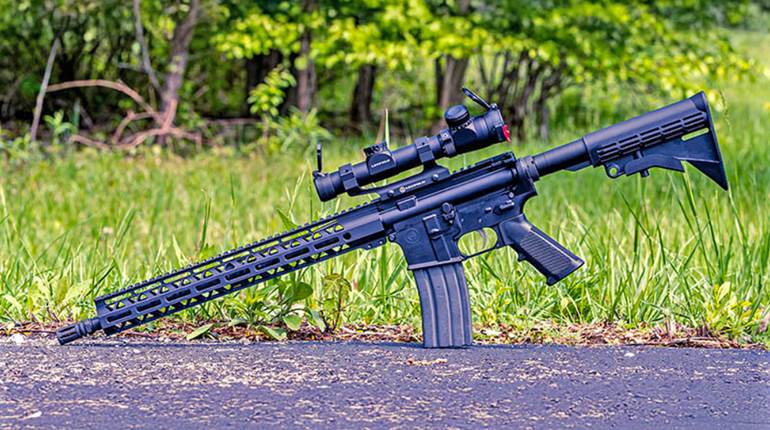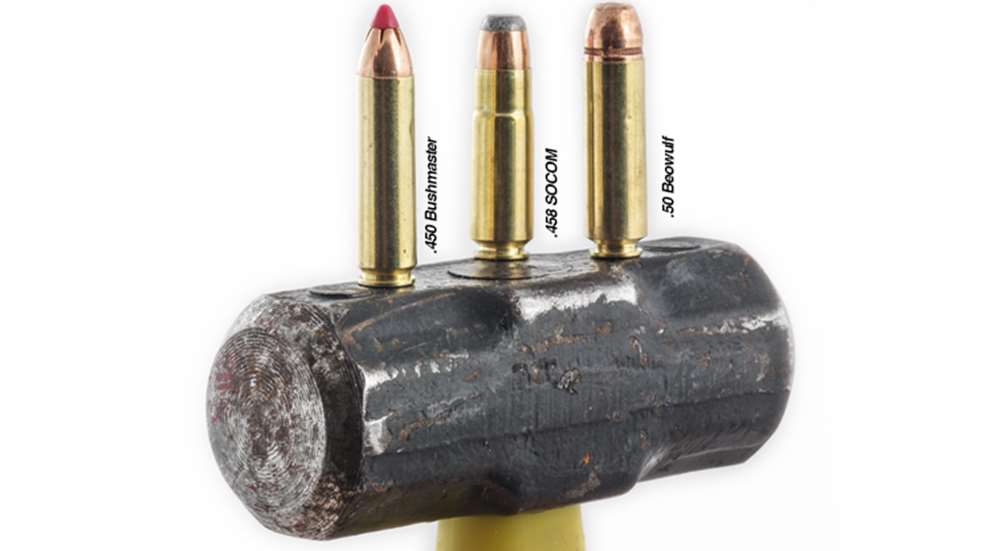
When it comes to dispatching game with authority—and a single shot—nothing gets the job done quite like the big, heavy bullets available in chamberings such as these three, which all fit in a standard AR-15-size platform.
I have a simple test when considering cartridges for hunting big game with an AR-15-style rifle. It simply requires honestly answering the question: If you were shopping for a non-AR rifle to hunt deer, bear or hogs would you pick one chambered for the cartridge you are willing to use in an AR-15? In other words, would you choose a bolt-action deer rifle chambered for .300 Blackout over say a .308 Win. or a .30-’06 Sprg.? The answer, of course, is no. Otherwise gunmakers would be flocking to build .300 Blackout bolt-action rifles. Why aren’t they? Because there just isn’t much of a market. As an example, Remington did introduce a bolt-action in 6.8 mm SPC, but has since dropped it due to poor sales.
The .223 Rem. is a good seller in a bolt-action hunting rifle, but not for big game. The vast majority of .223 Rem. bolt-action rifles are purchased for hunting varmints. The few .300 Blackout bolt-action rifles I have seen are designed for tactical use and to be used suppressed—not for deer hunting.
Big-game hunters use the .300 Blackout, 6.8 mm SPC or .223 Rem. in AR-15s because of the platform, not the ballistics. Sure, they can all kill game, but I’d argue that they make shot placement even more critical than more powerful cartridges traditionally used to hunt deer, bear or hogs.
The trouble with the AR-15 platform is the limitations it puts on cartridge length. It’s hard to make the gun work with a cartridge much longer than 2.26". Of course, you can move up to the larger AR-L (AR-10) platform that is based on the .308 Win.-size cartridges, but the guns are bigger, heavier and more expensive.
Oddly enough, back in the early days of self-contained metallic cartridges, new cartridge designers faced a similar dilemma, but for very different reasons. The combination of blackpowder and early bullet construction limited velocity to around 1,500 f.p.s., give or take. So, to increase power, the cartridge designers made the bullets heavier and bigger in diameter. That’s why the military’s rifle cartridges were .45-caliber in the 1870s rather than the .22 caliber used today.
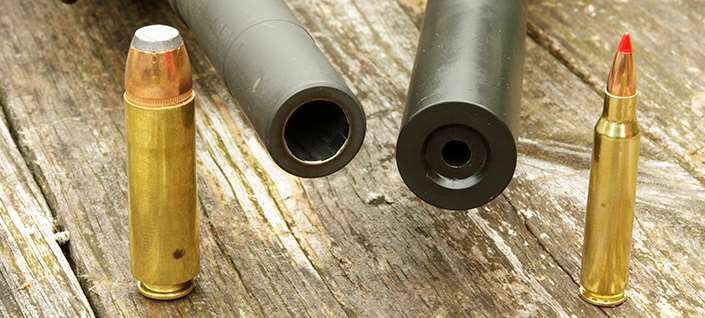
Today’s hard-hitting hunting cartridges for the AR-15 use the same concept. If you can’t make the cartridge longer, then make it larger in diameter and add some bullet weight.
Just as the hunters using the old blackpowder cartridges understood, a big-diameter, heavy bullet at moderate velocity is deadly on big game.
The lineup of big-bores is not huge for the AR-15 platform. In fact, from mainstream gunmakers there are only three cartridges. But that’s enough, as each member of this trio brings something impressive to the table.
.450 Bushmaster
This is the smallest of the thumpers, with a bullet diameter of .452". It uses a rebated rim cartridge case based on the .284 Win. case.
The concept behind what would become the .450 Bushmaster was initially put forth by Col. Jeff Cooper. Cooper is best known for creating the “Modern Technique” of handgun shooting and for his admiration of the M1911 pistol. But Cooper was also an avid hunter and loved to roam wild places in a “come what may” sort of way. He was a man of great experience, having hunted all over the world, and he recognized that a big bullet is a good thing when shooting big game. He thought that the perfect rifle for most “general” big-game hunting would be a semi-automatic of larger than .44 caliber that was capable of taking big game out to 250 yds. He called this the “Thumper” concept.
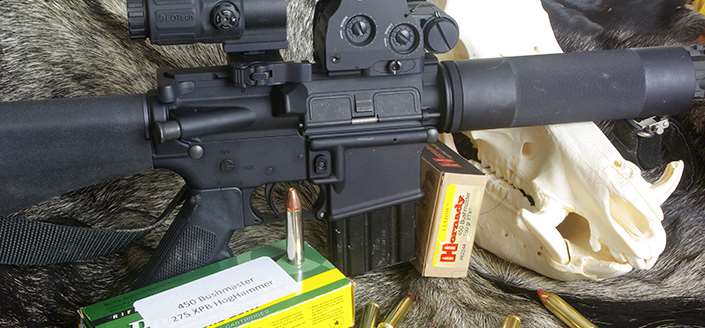
Tim LeGendre of LeMag Firearms developed his version of the cartridge, and called it the .45 Professional. He licensed the concept to Bushmaster Firearms Int’l for production and distribution, while Hornady developed the ammunition. Hornady modified the case a little so it would work better with its SST Flextip bullet. The name was then changed to .450 Bushmaster, with the blessing of LeGendre, and the cartridge was introduced in 2007.
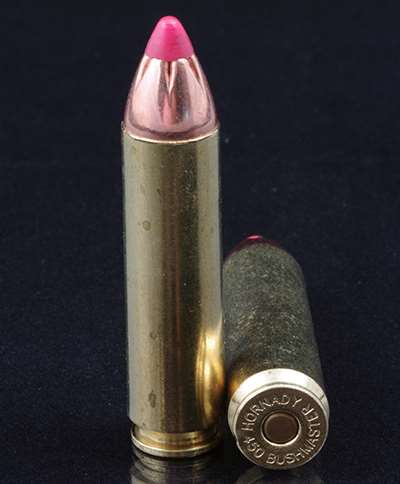
The current Hornady .450 Bushmaster load uses a 250-gr. FTX bullet with a factory advertised muzzle velocity of 2,200 f.p.s. from a 20" barrel for 2,686 ft.-lbs. of energy. On my chronograph this load has a velocity of 2,090 f.p.s. fifteen feet from the muzzle when fired from my Bushmaster rifle with a 16" barrel. This produces 2,425 ft.-lbs. of energy at the muzzle.
The Remington Outdoor Group owns Bushmaster, so it makes sense that Remington would start making ammunition in that chambering. Big Green currently offers a 260-gr. Premier Accutip load with an advertised muzzle velocity of 2,180 f.p.s. Muzzle energy is 2,744 ft.-lbs. This ammunition produces 2,062 f.p.s. and 2,455 ft.-lbs. of energy from my rifle’s shorter barrel.
I shot a bunch of hogs using some pre-production ammunition from Remington that was loaded with 275-gr. Barnes XPB Bullets. From my rifle, the velocity is 2,009 f.p.s. and the energy is 2,465 ft.-lbs. They have decided not to introduce the load, but it is easy to handload using the Barnes bullet, listed in that company’s catalog as being for the .460 S&W.
I also shot an Asian water buffalo that weighed more than three-quarters of a ton with that load. I was very impressed with all of the results. I will admit, this cartridge is probably a bit on the light side for hunting animals of that size, but it’s the gun I had with me when opportunity knocked, which is exactly the concept that Cooper envisioned.
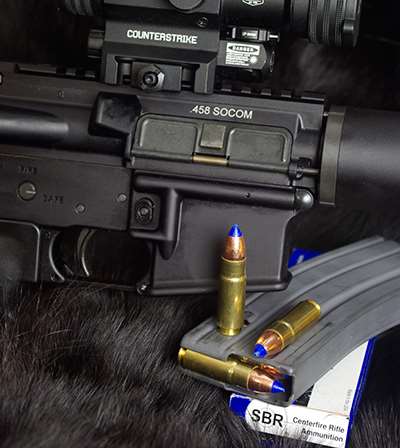
.458 SOCOM
The .458 SOCOM was developed for military applications after the fighting in Mogadishu, Somalia, in 1993. That battle left a lot of participants disappointed in the performance of the 5.56x45 mm NATO cartridge, and they wanted some serious, .45-70 Gov’t-class thumping power for the M16 and M4 rifles. It’s worth considering that if the guys in the fight don’t think the .223 is enough gun, perhaps we should re-evaluate its use for hunting such animals as hogs, bear, moose and elk—game that often runs bigger and tougher than the average man.
The .458 SOCOM cartridge came out in 2002, and while it didn’t gain widespread acceptance as a military round, it has proven to be a great hunting cartridge. It uses a lengthened .50 AE case with a rebated rim and is necked down for a .458" bullet. One big advantage with that .458 diameter is there is a wide selection of rifle bullets on the market. This is reflected in the multiple factory load options, and it opens a lot of doors for handloaders. One of the best bullets is the 300-gr. TTSX that Barnes developed specifically for this cartridge.
Factory-loaded ammunition is currently offered from three companies that I can find: Wilson Combat, Southern Ballistics Research (SBR) and Cor-Bon. Rifles are available from Rock River Armory, Wilson Combat and, in custom form, from SBR. My test rifle is a Rock River with a 16" barrel.
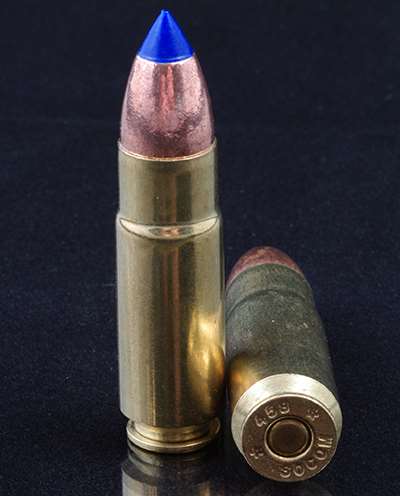
Cor-Bon has a load using the Barnes TTSX 300-gr. bullet at an advertised muzzle velocity of 1,825 f.p.s. It also offers a 300-gr. HP at 1,900 f.p.s. From my 16" barreled test gun, muzzle velocity for the 300-gr. Barnes load was 1,894 f.p.s., which is slightly higher than advertised. The Wilson Combat 300-gr. Barnes TTSX load produced 1,834 f.p.s. and 2,241 ft.-lbs. of muzzle energy from the Rock River.
SBR offers 16 different loads for the .458 SOCOM with bullets ranging from 140 to 500 grs. I tested the 300-gr. JHP load and got 1,831 f.p.s. and 2,234 ft.-lbs. of energy.
After testing two different Rock River .458 SOCOM carbines, the CAR A-4 and the new X-1, I have been very impressed with the accuracy. Both shot right around the 1 minute-of-angle mark with just about any ammunition I tried.
It might have a military background, but the .458 SOCOM is a big-game cartridge capable of taking anything that walks in North America.
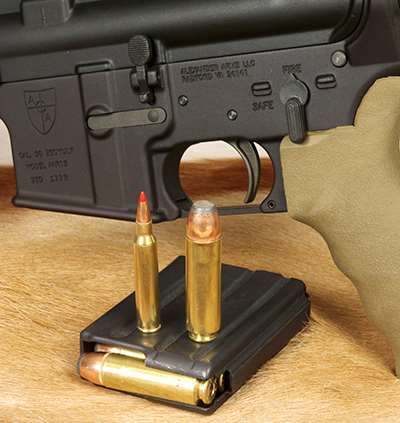
.50 Beowulf
As you have probably figured out by now, I am not a fan of small cartridges for hunting. I have hunted with most of the popular cartridges of all sizes over the years and continue to today, as I think experience is the best way to gain knowledge. But I have come to believe that each category of game has a list of specific cartridges that are appropriate for use. I tend to gravitate toward the upper 50 percent of that list in size and power. I like cartridges that hit hard and remove the doubt. The .50 Beowulf epitomizes that concept. With a 334-gr., 1/2" diameter bullet at nearly 2,000 f.p.s., there is never any doubt when you hit something.
Bill Alexander of Alexander Arms was one of the pioneers of big-game hunting cartridges in AR-15 style rifles. He developed this cartridge and named it after Beowulf, a legendary warrior of Old English literature who slayed the undefeatable Grendel by ripping his arm off. The day after that battle, Beowulf battled the horrible monster that was Grendel’s mother. He killed her by cutting off her head with a mighty sword from her own armory. A sword of which it was said, “no other man could have hefted in battle.” Years later, in his doddering old age when he was worn out and feeble, Beowulf fought and killed a dragon.
In short, Beowulf was big and bad and backed down from no fight; the perfect namesake for this cartridge. When it was introduced in 2001 the .50 Beowulf was the first of the AR-15-specific, ultra-big-bore cartridges to be offered by an AR manufacturer. It is based on a lengthened .50 AE case with a severely rebated rim so that it fits a bolt head designed for the 7.62x39 mm cartridge. This bolt face size works well with an AR-15 style rifle.
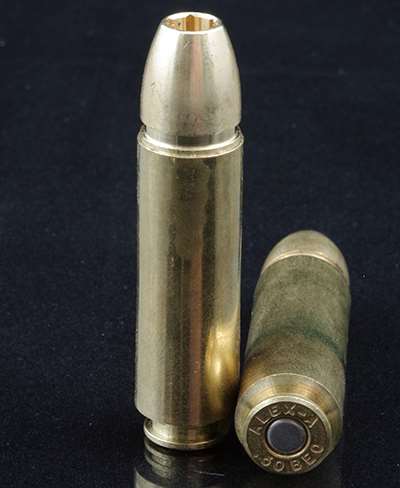
From a 24" barrel, the .50 Beowulf pushes a 334-gr. bullet to 1,980 f.p.s. and 2,908 ft.-lbs. of energy at the muzzle. The 400-gr. load has a muzzle velocity of 1,875 f.p.s. and 3,123 ft.-lbs. The bullet is 1/2" in diameter and can expand to more than 1". Compare that to a 55-gr. .223 Rem. at less than half the diameter. The 334-gr. Beowulf has 507 percent more bullet weight and an unexpanded diameter that is larger than a .223’s fully expanded bullet. Once they both have expanded, the Beowulf bullet has a 123 percent larger frontal area than the .223 (based on two times expansion). Not to mention that the Beowulf has almost three times more energy than the .223 Rem. This is a serious step up in power for the AR-15 platform.
Even from the stubby 16.5" barrel on my rifle, the .50 Beowulf loads are moving at 1,938 f.p.s. for the 334-gr. bullet, and 1,800 f.p.s. for the 400-gr. That is 2,786 ft.-lbs. of muzzle energy for the 334-gr. and 2,878 ft.-lbs. for the 400-gr. load. Considering the 7.5" difference in barrel length, the velocity loss is minimal. Clearly this is a cartridge that is well-suited to the shorter barrels often used on the AR-15.
I have used the .50 Beowulf on multiple hogs and a few deer, always with very good results. With the right bullets it hits hard, penetrates well and leaves a very large hole in its wake. Just as Sir Samuel Baker said about his 2-bore rifle, “Baby,” I can honestly say that I have never lost a single animal hit with this cartridge! I don’t even need to rely on exploding bullets for that result as he did.
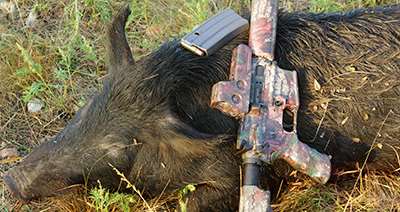
Obviously these cartridges are not designed for long range. But, all the recent “sniper” hype aside, the truth is that most big game is shot at well under 200 yds. anyway. If you don’t like to track game after the shot, these cartridges will get the job done on any big game in North America.
So to answer my own question, “Would I buy a non-AR-15 rifle for hunting if it were chambered in one of these cartridges?” I would welcome any of these cartridges in any rifle. A short-action bolt gun would be very interesting, and I think they would be great in a lever-action. In fact, I have hunted for years with cartridges with similar ballistic performance, such as the .444 Marlin, .45-70 Gov’t and .450 Marlin. So the answer is pretty much, “been there, done that,” only now I get to use an AR.














